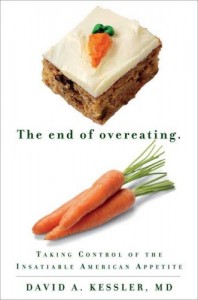I read this book a little bit ago by David A. Kessler called The End of Overeating, and shortly after went to a talk at UCLA titled “Addiction and Obesity: Are they related maladaptive behaviors?” It got me thinking about the connection between drug addiction and food addiction. It’s already well established that drug use initiates the dopamine-mediated reward pathway, and in susceptible individuals can incite a downhill spiral of use even in the face of terrible consequences in the person’s life. Animal studies have shown that laboratory rats will continue to press a lever that gives them cocaine until they die, ignoring levers next to them that supply food and water.
What’s now better understood is that sugar, salt and fat can have these same addictive qualities. For example, one study described in Kessler’s book showed that well-fed rats would cross an electrified floor to get to sweetened cereal, even when hungry rats wouldn’t cross that same floor to get to regular food pellets. Which, to me, seemed crazy and surprising. The study was effectively saying that fruit loops can be as addictive as cocaine.
Another study discussed at the UCLA talk demonstrated that on an isocaloric diet (that is, a diet with the same amount of calories but a different proportion of those calories from sugar), eating increased amounts of sugar decreased satiety, suggesting that the more sugar we consume, the less we are satisfied and the more hungry we get, which can lead to eating even more sugar. And while sugar is bad, high fructose corn syrup is the worst – despite what the food industry promotes, the evidence strongly suggests that high fructose corn syrup is treated differently by the body than other sugars, bypassing normal hormonal responses and metabolizing directly to fat.
What’s scary is that the food industry understands, maybe not scientifically, but at least intuitively, the addictive nature of sugar, salt and fat, and manipulates foods to make them more enticing, irresistible and “hyperpalatable” (word taken from Kessler’s book). Kessler talks about how food scientists who work for such delicious chains such as Chilis, Cheesecake Factory and Applebees basically engineer their food to be insanely delicious. For example, they’ve found that more sugar and more salt just won’t do – there needs to be a specific proportion of each compared to the other to be the most tasty and palatable. Unfortunately, their methods often make the food incredibly bad for you.
So what’s the average food addict to do? Kessler talks about “food rehab,” which is the process of retraining yourself to eat properly, and not to overeat just because there’s appetizing food around. I can’t claim to be an expert on this as I haven’t exactly been immune from hospital cafeteria pizza and frozen yogurt. That being said, I have found in my personal experience that eating habits, both good and bad, are trained and ingrained. When I start veering into bad habits, I need to actively focus on redirecting the way I eat, and then after a while, I don’t even have to think about it because healthy foods sound more appetizing.
Anyway, if you want to learn more, you can check out The End of Overeating by David Kessler:



Leave a Reply